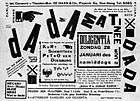Raoul Hausmann
Raoul Hausmann (July 12, 1886 – February 1, 1971) was an Austrian artist and writer. One of the key figures in Berlin Dada, his experimental photographic collages, sound poetry and institutional critiques would have a profound influence on the European Avant-Garde in the aftermath of World War I.
Raoul Hausmann | |
|---|---|
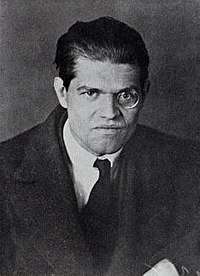 Raoul Hausmann, taken by Hannah Höch, 1919 | |
| Born | Raoul Hausmann July 12, 1886 |
| Died | February 1, 1971 (aged 84) Limoges, France |
| Nationality | Austrian |
| Known for | Collage, Photography, Sculpture, Poetry, Performance, Theory |
Notable work | Mechanical Head [The Spirit of Our Age], c. 1920 |
| Movement | Dada |
Early biography
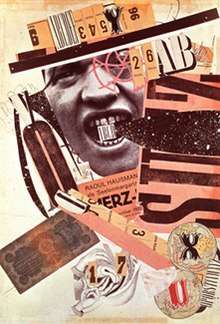
Raoul Hausmann was born in Vienna but moved to Berlin with his parents at the age of 14, in 1901.[1] His earliest art training was from his father, a professional conservator and painter. He met Johannes Baader, an eccentric architect and another future member of Dada, in 1905. At around the same time he met Elfride Schaeffer, a violinist, whom he married in 1908, a year after the birth of their daughter, Vera. That same year Hausmann enrolled at a private Art School in Berlin,[2] where he remained until 1911.
After seeing Expressionist paintings in Herwarth Walden's gallery Der Sturm in 1912, Hausmann started to produce Expressionist prints in Erich Heckel's studio, and became a staff writer for Walden's magazine, also called Der Sturm, which provided a platform for his earliest polemical writings against the art establishment. In keeping with his Expressionist colleagues, he initially welcomed the war, believing it to be a necessary cleansing of a calcified society, although being an Austrian citizen living in Germany he was spared the draft.
Hausmann met Hannah Höch in 1915, and embarked upon an extramarital affair that produced an 'artistically productive but turbulent bond'[3] that would last until 1922 when she left him. The relationship's turmoil even reached the point where Hausmann fantasized about killing Höch.[4] He spoke down to her about her opinions on everything from politics to art, and only came to her aid when the other artists of the Dada movement tried to exclude her from their art shows.[5] Even after defending her art and arguing for its inclusion in the First International Dada Fair, he went on to say Höch "was never part of the club."[6] Though Hausmann repeatedly told Höch that he was going to leave his wife to be with her, he never did.[7]
In 1916 Hausmann met two more people who would become important influences on his subsequent career; the psychoanalyst Otto Gross who believed psychoanalysis to be the preparation for revolution, and the anarchist writer Franz Jung. By now his artistic circle had come to include the writer Salomo Friedlaender, Hans Richter, Emmy Hennings and members of Die Aktion magazine, which, along with Der Sturm and the anarchist paper Die Freie Straße[8] published numerous articles by him in this period.
'The notion of destruction as an act of creation was the point of departure for Hausmann's Dadasophy, his theoretical contribution to Berlin Dada.'[9]
Berlin Dada
When Richard Huelsenbeck, a 24-year-old medical student who was a close friend of Hugo Ball and one of the founders of Dada, returned to Berlin in 1917, Hausmann was one of a group of young disaffected artists that began to form the nucleus of Berlin Dada around him. Huelsenbeck delivered his "First Dada Speech in Germany", January 22, 1918 at the fashionable art dealer IB Neumann's gallery, Kurfürstendamm Berlin. Over the course of the next few weeks, Hausmann, Huelsenbeck, George Grosz, John Heartfield, Jung, Höch, Walter Mehring and Baader started the Club Dada. The first event staged was an evening of poetry performances and lectures against the backdrop of a retrospective of paintings by the establishment artist Lovis Corinth at the Berlin Sezession, April 12, 1918. Amongst the contributors, Huelsenbeck recited the Dada Manifesto, Grosz danced a "Sincopation" homaging Jazz, whilst Hausmann ended the evening by shouting his manifesto The New Material In Painting at the by-now near riotous audience;
"The threat of violence hung in the air. One envisioned Corinth's pictures torn to shreds with chair legs. But in the end it didn't come to that. As Raoul Hausmann shouted his programmatic plans for dadaist painting into the noise of the crowd, the manager of the sezession gallery turned the lights out on him."[10]
Photomontage
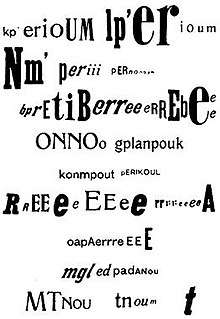
The call for new materials in painting bore fruit later the same year when Hausmann and Höch holidayed on the Baltic Sea. The guest room they were staying in had a generic portrait of soldiers, onto which the patron had glued photographic portrait heads of his son five times.
"It was like a thunderbolt: one could – I saw it instantaneously – make pictures, assembled entirely from cut-up photographs. Back in Berlin that september, I began to realize this new vision, and I made use of photographs from the press and the cinema." Hausmann, 1958[11]
The photomontage became the technique most associated with Berlin Dada, used extensively by Hausmann, Höch, Heartfield, Baader and Grosz, and would prove a crucial influence on Kurt Schwitters, El Lissitsky and Russian Constructivism. It should also be pointed out that Grosz, Heartfield and Baader all laid claim to having invented the technique in later memoirs, although no works have surfaced to justify these claims.
At the same time, Hausmann started to experiment with sound poems he called "phonemes"[12] and "poster poems", originally created by the chance lining up of letters by a printer without Hausmann's direct intervention.[13] Later poems used words which were reversed, chopped up and strung out, then either typed out using a full range of typographical strategies, or performed with boisterous exuberance. Schwitters' Ursonate was directly influenced by a performance of one of Hausmann's poems, "fmsbwtazdu", at an event in Prague in 1921.[14]
Der Dada: a new periodical
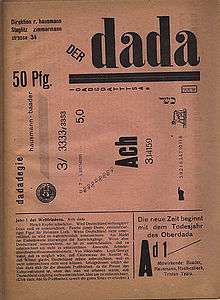
After Hausmann contributed to the first group show, held at Isaac Neumann's Gallery, April 1919, the first edition of Der Dada appeared in June 1919. Edited by Hausmann and Baader, after receiving permission from Tristan Tzara in Zurich to use the name, the magazine also featured significant contributions from Huelsenbeck. The periodical contained drawings, polemics, poems and satires, all typeset in a multiplicity of opposing fonts and signs.
At the beginning of 1920, Baader, the "Oberdada", Hausmann, the “Dadasoph", and the "Welt-Dada" Huelsenbeck undertook a six-week tour of Eastern Germany and Czechoslovakia, drawing large crowds and bemused reviews. The programme included primitivist verse, simultaneous poetry recitals by Baader and Hausmann, and Hausmann's "Dada-Trot (Sixty-One Step)" described as 'a truly splendid send-up of the most modern exotic-erotic social dances that have befallen us like a plague...'[15]
The First International Dada Fair, 1920
Organised by Grosz, Heartfield and Hausmann, the fair was to become the most famous of all Berlin Dada's exploits, featuring almost 200 works by artists including Francis Picabia, Hans Arp, Ernst and Rudolf Schlichter, as well as key works by Grosz, Höch and Hausmann. The work Tatlin At Home, 1920, can be clearly seen in one of the publicity photos taken by a professional photographer; the exhibition, whilst financially unsuccessful, gained prominent exposure in Amsterdam, Milan, Rome and Boston.[16] The exhibition also proved to be one of the main influences on the content and layout of Entartete Kunst, the show of degenerate art put on by the Nazis in 1937, with key slogans such as "Nehmen Sie DADA Ernst", "Take Dada Seriously!", appearing in both exhibitions.
The Mechanical Head
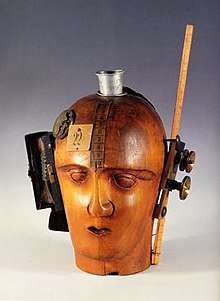
The most famous work by Hausmann, Mechanischer Kopf (Der Geist Unserer Zeit), "The Mechanical Head (The Spirit of Our Time)", c. 1920, is the only surviving assemblage that Hausmann produced around 1919–20. Constructed from a hairdresser's wig-making dummy, the piece has various measuring devices attached including a ruler, a pocket watch mechanism, a typewriter, some camera segments and a crocodile wallet.[17]
"Der Geist Unserer Zeit – Mechanischer Kopf specifically evokes the philosopher George Wilhelm Friedrich Hegel (1770–1831). For Hegel...everything is mind. Among Hegel's disciples and critics was Karl Marx. Hausmann's sculpture might be seen as an aggressively Marxist reversal of Hegel: this is a head whose "thoughts" are materially determined by objects literally fixed to it. However, there are deeper targets in western culture that give this modern masterpiece its force. Hausmann turns inside out the notion of the head as seat of reason, an assumption that lies behind the European fascination with the portrait. He reveals a head that is penetrated and governed by brute external forces.[18]
After Dada
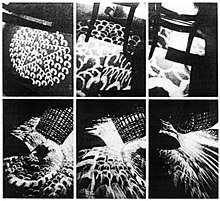
Friendship with Schwitters
Huelsenbeck finished his training to become a doctor in 1920 and started to practice medicine; by the end of the year he had published the Dada Almanach and The History of Dadaism, two historical records that implied that Dada was at an end. In the aftermath, Hausmann's friendship with Kurt Schwitters deepened, and Hausmann started to take steps toward International Modernism. In September 1921, Hausmann, Höch, Schwitters and his wife Helma undertook an 'anti-dada' tour to Prague. As well as his recitals of sound poems, he also presented a manifesto describing a machine "capable of converting audio and visual signals interchangeably, that he later called the Optophone".[19] After many years of experimentation, this device was patented in London in 1935. He also took part in an exhibition of photomontages in Berlin in 1931, organised by César Domela Nieuwenhuis.[20]
In the late 1920s, he re-invented himself as a fashionable society photographer, and lived in a ménage à trois with his wife Hedwig and Vera Broido in the fashionable district of Charlottenburg, Berlin. Hannah Höch - by now herself living with a woman, the Dutch author Til Brugman – left a sketch of Hausmann around 1931:
"After I had offered to renew friendly relations and we met frequently (with Til as well). At the time he was living with Heda Mankowicz-Hausmann and Vera Broido in Kaiser-Friedrich-Straße in Charlottenburg. Elfrided Hausmann-Scheffer, Til and I went there often. But I always found it very boring. He was just acting the photographer, and the lover of Vera B, showing off terribly with what he could afford to buy now – the ésprit was all gone." Hannah Höch[21]
In later years, Hausmann exhibited his photographs widely, concentrating on nudes, landscapes and portraits. As Nazi persecution of avant-garde artists increased, he emigrated to Ibiza, where his photos concentrated on ethnographic motifs of pre-modern Ibizan life. He returned to Czechoslovakia in 1937, but was forced to flee again in 1938 after the German invasion. He moved to Paris, then Peyrat-le-Château, near Limoges, living there illegally with his Jewish wife Hedwig, in a quiet, secluded manner, until 1944 . After the Normandy landings in 1944, the pair finally moved to Limoges.
The war over, Hausmann was once again able to work openly as an artist. He resumed correspondence with Schwitters with the aim to collaborate on a poetry magazine, PIN, but Schwitter's death in 1948 stopped the project. He published books about Dada, including the autobiographical Courier Dada, (1958). He also worked on "photograms", photomontages and sound poetry, and even returned to painting in the Fifties.
Revival of interest in Dada
In the 1950s there was a revival of interest in Dada, especially in America. As interest grew, Hausmann began corresponding with a number of leading American artists, discussing Dada and its contemporary relevance. He refuted the term Neo-Dada, currently in vogue, which had been applied to a number of artists including Yves Klein and the Nouveau Réalistes, Robert Rauschenberg and Fluxus.
'His almost complete isolation was relieved only by extensive and partly conflict-ridden correspondence with old friends from the Dada movement as well as young writers and artists such as Jasper Johns, Wolf Vostell and Daniel Spoerri.'[22]
He wrote to George Maciunas, who had included his work in the early Fluxfests, in 1962:
"I think even the Americans should not use the term "neodadaism" because neo means nothing and ism is old-fashioned. Why not simply "Fluxus"? It seems to me much better, because it's new, and dada is historic. I was in correspondence with Tzara, Hulsenbeck and Hans Richter concerning this question, and they all declare "neodadaism does not exist"... So long."[23]
He died on February 1, 1971, in Limoges.
Scientific interests and technical work
In addition to his work as an artist, Hausmann was interested in science and technology throughout his career, especially emerging fields like television and sound film, and Einstein's work on relativity (which Hausmann rejected).[24] In 1929, he received a patent for a "device for monitoring body cavities and tubes," which today we would call an endoscope (patent number DRP473166). While researching light and electronics for his artworks, Hausmann collaborated with a Russian engineer Daniel Broido to design a computer that used similar technology. The device was granted a patent by the British patent office in 1934 (patent number GB446338).[25]
Notes
- Raoul Hausmann at Kunstbus (Dutch)
- Arthur Lew-Funcke's Atelier for Painting and Sculpture
- Dada, Dickerman / Sabine T Kriebel, National Gallery of Art Washington, 2006 p472
- Maria Makela (1996). "By Design: The Early Work of Hannah Höch in Context". In Boswell, Peter; Makela, Maria; Lanchner, Carolyn (eds.). The photomontages of Hannah Höch (1. ed.). Minneapolis: Walker Art Center. p. 64. ISBN 9780935640526.
- Makela, Maria (1997). von Ankum, Katharina (ed.). Women in the Metropolis: Gender and Modernity in Weimar Culture. Berkeley: University of California Press. pp. 119–121.
- Hemus, Ruth (2009). Dada's Women. United States: Yale University Press. p. 92. ISBN 9780300141481.
- Makela, Maria (1997). von Ankum, Katharina (ed.). Women in the Metropolis: Gender and Modernity in Weimar Culture. Berkeley: University of California Press. pp. 119–121.
- de:Die freie Straße On German Wikipedia
- Quoted in Dada, Dickerman/ Sabine T Kriebel, National Gallery of Art Washington, 2006 p472
- Contemporaneous review from the Berliner Börsen-Courier, quoted in Dada, Dickerman, National Gallery of Art Washington, 2006 p88
- Quoted in Dada, Dickerman, National Gallery of Art Washington, 2006 p90
- Jas H. Duke. "Sounds, sound poetry, and sound/text compositions, Jas. H. Duke". Rainerlinz.net. Retrieved July 20, 2013.
- "Relations between sound poetry and visual poetry, Christian Scholz". Findarticles.com. Retrieved July 20, 2013.
- "UbuWeb Sound - Kurt Schwitters". Ubu.com. May 5, 1932. Retrieved July 20, 2013.
- Hamburger Nachrichten, 1920, quoted in Dada, p440-1
- Dada, Dickerman, National Gallery of Art, Washington, 2006, p100
- "Dada Biographies, NGA, Washington". Nga.gov. Archived from the original on April 2, 2013. Retrieved July 20, 2013.
- Jonathan Jones. "The Spirit of Our Time - Mechanical Head, Raoul Hausmann (1919)". Retrieved December 21, 2014.
- Dada, Dickerman, National Gallery of Art Washington, 2006 p446
- "Cesar Domela". Kunstbus.nl. December 31, 1992. Retrieved July 20, 2013.
- Collages, Hannah Höch 1889-78, Institute for Foreign Cultural Relations,1985.p54
- "Raoul Hausmann - Biography and Offers - Buy and Sell". Kettererkunst.com. Retrieved July 20, 2013.
- Mr Fluxus, Williams and Noël, Thames and Hudson, 1998, p40
- Ether Machines: Roaul Hausmann's Optophonetic Media, Arndt Niebisch, p162
- The Dada Computer
References
- Raoul Hausmann : Kamerafotografien, 1927–1957 / Andreas Haus.Schirmer-Mosel, c1979.
- Hausmann, Raoul and Schwitters, Kurt; ed. Jasia Reichardt. PIN, Gaberbocchus Press (1962); Anabas-Verlag, Giessen (1986).
- Collages, Hannah Höch 1889-78, Institute for Foreign Cultural Relations,1985
- Kurt Schwitters, Center Georges Pompidou, 1994
- Dada, Dickerman/ Sabine T Kriebel, National Gallery of Art Washington, 2006
- Hausmann at Artchive
- Cut and Paste, a History of Photomontage
Further reading
| Wikimedia Commons has media related to Raoul Hausmann. |
- Bergius, Hanne Das Lachen Dadas. Die Berliner Dadaisten und ihre Aktionen. Gießen: Anabas-Verlag, 1989. ISBN 978-3-8703-8141-7
- Bergius, H. Montage und Metamechanik. Dada Berlin - Ästhetik von Polaritäten (mit Rekonstruktion der Ersten Internationalen Dada-Messe und Dada-Chronologie) Berlin: Gebr. Mann Verlag 2000. ISBN 978-3-786115-25-0
- Bergius, H. Dada Triumphs! Dada Berlin, 1917-1923. Artistry of Polarities. Montages - Metamechanics - Manifestations. Translated by Brigitte Pichon. Vol. V. of the ten editions of Crisis and the Arts. The History of Dada, ed. by Stephen Foster, New Haven, Conn. u.a., Thomson/ Gale 2003. ISBN 978-0-816173-55-6
- Biro, M. The Dada Cyborg: Visions of the New Human in Weimar Berlin. Minneapolis: University of Minnesota Press, 2009. ISBN 0-8166-3620-6
External links
- Raoul Hausmann correspondence, Getty Research Institute. Includes list of collection holdings as well as biographical information
